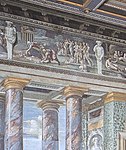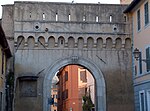Palazzo Corsini, Rome
1740 establishments in the Papal StatesArt museums and galleries in RomeGalleria Nazionale d'Arte AnticaHouses completed in 1740National museums of Italy ... and 2 more
Palaces in RomeRome R. XIII Trastevere

The Palazzo Corsini is a prominent late-baroque palace in Rome, erected for the Corsini family between 1730 and 1740 as an elaboration of the prior building on the site, a 15th-century villa of the Riario family, based on designs of Ferdinando Fuga. It is located in the Trastevere section of the city, and stands beside the Villa Farnesina.
Excerpt from the Wikipedia article Palazzo Corsini, Rome (License: CC BY-SA 3.0, Authors, Images).Palazzo Corsini, Rome
Via della Lungara, Rome Municipio Roma I
Geographical coordinates (GPS) Address External links Nearby Places Show on map
Geographical coordinates (GPS)
| Latitude | Longitude |
|---|---|
| N 41.893329 ° | E 12.466586 ° |
Address
Palazzo Corsini alla Lungara
Via della Lungara
00120 Rome, Municipio Roma I
Lazio, Italy
Open on Google Maps








